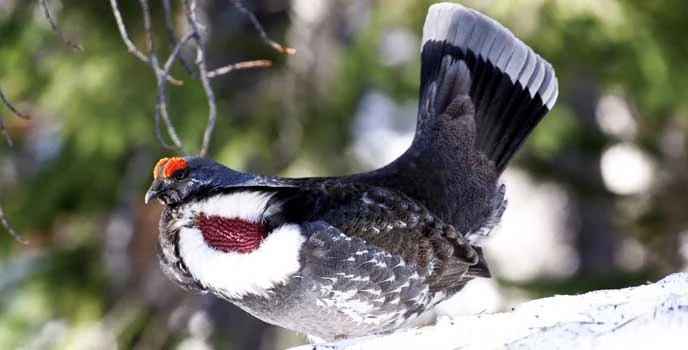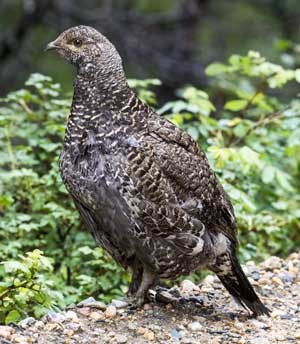
NPS 
NPS Dendragapus ObscurusLength: 15.7-19.7 in. (40-50 cm) - Weight: 26.5-45.9 oz. (750-1300 g) General DescriptionBlue Grouse (recently split to two species, the Sooty Grouse and Dusky Grouse)are the second largest grouse in North America (the largest grouse is the sage grouse). Males can weigh up to three pounds and females and juveniles about two pounds. Males are a slate-gray or blue-gray, while females are more mottled brown. Both sexes have a pale gray band on their rounded or fan-shaped tail, however the band is more distinct in males. White markings are present on the flanks and under the tail feathers. Feathering extends to the base of the middle toe. The eye comb of the male is yellow to orange and the females have smaller areas of bare skin over the eyes. Males have white feathers surrounding the cervical sacs while the white feathers and cervical sacs are absent in females. HabitatDusky grouse are considered forest grouse, but during different times of the year they utilize distinctly different habitat types. In the winter, dusky grouse live in the high country, roosting and feeding in stands of Douglas fir and lodge pole pine. In the spring, dusky grouse leave the high country and move to their breeding grounds. They may breed in a variety of habitats, including sub-alpine meadows and creek bottoms. Although, their preferred breeding habitat is near the aspen sagebrush interface. Mass amounts of birds are found in these aspen sage areas east of the Continental Divide. West of the divide, the largest population of birds is found in areas where aspen and sagebrush combine with shrubs such as oakbrush, serviceberry and chokecherry. These areas remain moist throughout the summer and provide the forbs (low growing flower plants such as clover and dandelion) and insects, which are crucial to the success of the young. BehaviorDusky Grouse are usually found alone, except for hens with young, and are fairly cautious. The sounds that this grouse makes consist of a series of five soft, very low-pitched hoots that can rarely be heard beyond 100 feet. Males sing from either the ground or from a low perch. Just before breeding males also strut with tails raised and fanned, and the neck feathers spread, revealing patches of bright skin. Grouse are mainly ground foragers, but will also scavenge for buds in deciduous trees and needles in coniferous trees. DietVaccinium, also known as blueberry or grouse whortleberry, is an important diet component for adult males in the fall. When the adult males leave the breeding grounds they generally move into the highest forest available, which has a vaccinium under story. Other food sources to the Grouse include insects, seeds, fruit, buds, and conifer needles. NestingThe nests are usually a shallow slump in the ground, covered with dead undergrowth and body feathers. The Dusky Grouse prefer to make their nests on the ground in a variety of areas. They have been seen nesting in open areas that have recently been burned and also in densely mixed coniferous forests. Eggs & IncubationThe Dusky Grouse eggs are pale white with brown markings. The Females will lay and incubate one to 12 lightly speckled eggs (normally four to nine) and provide all parental care. The young leave the nest within a day after hatching. Females will tend to the young, but will not feed them. Migration StatusEarly fall, Dusky Grouse migrate short distances to a higher elevation in a dense forest and will return to their breeding grounds in the spring. Interesting FactsThe number of tail feathers a bird has is usually constant within a species (and usually numbers around 10). The Dusky Grouse, however, can have from 15 to 22 tail feathers.
1
|
Last updated: May 3, 2018
